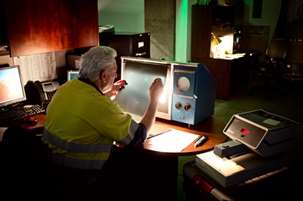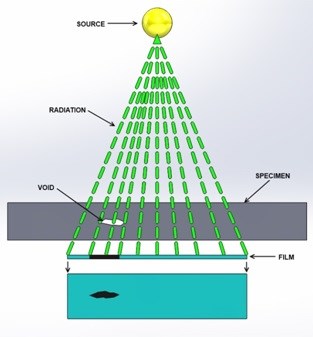Non-Destructive Radiographic Inspection of Steel Castings
Radiographic inspection technology has been used for industrial inspection for decades.
#automation
VM: What are the methods used to verify internal soundness of steel castings?
Truselo: There are two primary methods used that are governed by ASTM standards.
One is ultrasonic inspection, which uses a transducer and diagnostic machine to send and receive an ultrasound waveform. The reflection or pulse-echo comes from either the back wall of the casting or any imperfection or cavity within the wall. The second technique is the use of radiography which uses X-rays and Gamma Rays.
VM: Describe the radiography process.
Truselo: In this process, X-rays produced by a generator are projected towards an object. Some of those X-rays are absorbed by the object while others pass through and are captured on the far side of the object by photographic film or digital detectors. Visual inspection of those resulting images will reveal internal flaws which can then be graded against ASTM standards.
The formation of an image on the film depends upon the amount of radiation received by different areas of the film. In the example above the void represents a thickness difference in the specimen. Since there is no material in the void the specimen is “thinner” in the area of the void and allows more radiation to be transmitted to the film in this area. The result is more exposure to the film in the area of the void resulting in a darker image on the film.
As lead is denser than steel, the areas where the location or station markers are located will absorb more of the gamma or X-rays than the surrounding steel base material. This will cause the image of these markers to show as minus density (lighter) images on the film.
If the material has non-metallic inclusions such as sand, slag, gas porosity or shrinkage, these areas are less dense than the surrounding sound material. As a result, more gamma or X-rays are transmitted through these areas and the exposure of the film is greater in these areas. The result is plus density (darker) images in the flawed areas on the film.
These flawed areas appearing on the exposed film are then evaluated by comparing to ASTM standard reference radiographs for acceptability using the steel casting industry’s three primary sets of reference radiographs based on material thickness. Each of these standard sets of reference radiographs contain 6 categories of graded discontinuities found in castings in increasing severities from 1 (best) to 5 (worst) and 4 categories of ungraded discontinuities furnished as examples only. The flawed areas on the film are first categorized as to the type of discontinuity (gas, sand, slag, shrinkage, etc.) and then evaluated for severity from 1 to 5.
VM: What is the difference in function between a linear accelerator and a projector?
Truselo: A projector is an exposure device that houses and shields a source of radioactive material, usually Iridium 192 or Cobalt 60. The source is “projected” to the desired location by drive cables and a crank assembly and retracted back into the shielded position after the exposure. A linear accelerator is a type of X-ray machine that produces very high energy X-Rays. The linear accelerator uses sophisticated technology to accelerate electrons in a part of the accelerator called the "wave guide," then allows these electrons to collide with a heavy metal target. As a result of the collisions, high-energy x-rays are produced from the target.
VM: Can different materials be inspected, or are they both needed for each project?
All materials can be inspected with both technologies. Having both provides additional capabilities. For example, since the radioactive material in the projector is connected to a drive cable, it can be positioned inside of casting waterways and blind passages to allow inspections of areas that are difficult to access. The linear accelerator allows for inspections of very thick wall sections that cannot be inspected by other means.
VM: What kinds of safety precautions are necessary when operating this kind of equipment?
Truselo: Any facilities are required to meet state and NRC requirements. In the case of the new building erected by Bradken, it had to meet Washington State requirements. There the final building included a vault with 8.0’ feet x 40.0’ feet high walls with an 18” thick concrete roof. In addition, personnel monitoring devices, film badges and dosimeters are worn by all personnel to monitor exposure to radiation. Survey meters and audible/visual alarm systems are used to prevent any unnecessary exposure to personnel.
VM: What requirements must be met by operators?
Truselo: Our facilities are operated by 16 radiographers and three film readers across three shifts. Radiographers are qualified to SNT-TC-1A Level II and III. Staff also includes MIL-STD-2132 and NAVSEA 250-1500-1 Test Examiner. Typically a minimum qualification of SNT-TC-1A Level is required for acceptance inspections.
VM: Are the images on film, or are they digital?
Truselo: Currently at Bradken only conventional film radiography is used. It is difficult to produce acceptable digital images on castings with complex configurations using very high energy (8 and 9 MeV). The technology is advancing rapidly however, and a digital system will be in place in the near future.
VM: What are the benefits/limitations of the two processing methods?
The most prevalent detriment to film radiography is that processing chemicals are an environmental issue. Also, because of the environmental issues and the onset of digital cameras for recreational use, the demand for film has decreased significantly. As a result, cost and availability for film is an issue that will probably only get worse as time goes on. Film storage also requires environmentally-controlled storage areas and can occupy large areas of space.
Digital imaging eliminates those issues but has not been universally accepted yet. Its use is still prohibited by many military specifications and older editions of the ASME Code. It also requires the end user to have sophisticated viewing equipment and compatible software.
Stan Truselo is the quality assurance manager at Bradken’s Tacoma facility. He can be reached at struselo@bradken.com.
Kate Kunkel is senior editor of VALVE Magazine. She can be reached at kkunkel@vma.org.
RELATED CONTENT
-
Hardfacing for Valves: Materials and Processes
Valve internals, such as seats and closures, are often at risk of erosion, abrasion, corrosion, galling and damage from cavitation.
-
The Misunderstood Check Valve
Too often this valve is unjustly blamed when problems occur, but the real culprit is its use in the wrong applications.
-
The Rationale Behind Valve Characteristics
Back in the “early days,” we were taught that, to properly control flow, we should select a linear valve characteristic when the valve controls more than 25% of the piping system pressure drop at full flow.












 Unloading large gate valve.jpg;maxWidth=214)
